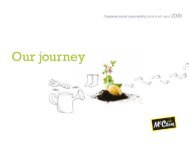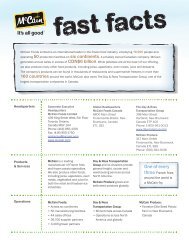From the Ground Up - McCain Foods Limited
From the Ground Up - McCain Foods Limited
From the Ground Up - McCain Foods Limited
You also want an ePaper? Increase the reach of your titles
YUMPU automatically turns print PDFs into web optimized ePapers that Google loves.
The Florenceville plant up and<br />
running in 1957.<br />
North America, <strong>the</strong>n to Europe and <strong>the</strong> rest of <strong>the</strong> world. <strong>McCain</strong> grew along with<br />
<strong>the</strong>m as one of <strong>the</strong>ir most important suppliers.<br />
It is fitting that one of <strong>the</strong> world’s major frozen food companies is based in Canada<br />
because it was <strong>the</strong> Inuit of Canada’s Far North who invented frozen food. Their<br />
favourite method of freezing a fish was to toss it on <strong>the</strong><br />
ice as soon as it was caught. The Inuit knew hundreds<br />
of years ago that a fish frozen quickly in <strong>the</strong> dead of<br />
winter tasted better when thawed than did a fish frozen<br />
more slowly in <strong>the</strong> spring or fall, when temperatures<br />
were milder.<br />
When food is frozen slowly, ice crystals form that<br />
damage <strong>the</strong> food’s cellular structure, <strong>the</strong>reby also damaging<br />
its colour, texture, and flavour. Quick-frozen<br />
food, on <strong>the</strong> o<strong>the</strong>r hand, is virtually indistinguishable from fresh once it has been<br />
thawed. Clarence Birdseye, of Brooklyn, New York, studied biology and <strong>the</strong>n worked<br />
as a fur trader in nor<strong>the</strong>rn Labrador, where he figured all this out by observing <strong>the</strong><br />
Inuit. Back in <strong>the</strong> United States, Birdseye invented a “quick freeze machine” and, in<br />
1925, founded Birdseye Seafoods.<br />
The business was not successful because <strong>the</strong> public, based on previous experience,<br />
disliked frozen food. As well, few grocery stores had freezers, and home refrigerators<br />
lacked freezer compartments. Four years later, Birdseye sold his company to General<br />
<strong>Foods</strong>, which kept <strong>the</strong> brand name but split <strong>the</strong> word in two – “Birds Eye.” Gradually,<br />
<strong>the</strong> frozen food business picked up and, during <strong>the</strong> 1950s, it enjoyed explosive growth<br />
as American families, now equipped with modern fridges and home freezers, discovered<br />
<strong>the</strong> joys of TV dinners and frozen orange juice.<br />
At <strong>the</strong> age of fifteen, Jack Simplot leased an Idaho potato farm and became one<br />
of <strong>the</strong> biggest shippers of potatoes in <strong>the</strong> western United States. The J.R. Simplot<br />
Dehydrating Company perfected a new method of dehydrating potatoes and, during<br />
World War II, became an important food supplier to <strong>the</strong> U.S. military. After <strong>the</strong><br />
war, Simplot decided that frozen foods were <strong>the</strong> wave of <strong>the</strong> future. And what better<br />
product to offer than <strong>the</strong> french fry, which was becoming increasingly popular and<br />
yet was so time-consuming to prepare?<br />
The problem was that raw potatoes that had been cut up and frozen turned to<br />
mush when thawed. Ray Dunlap, a scientist working<br />
for Simplot, solved <strong>the</strong> problem. He found that precooking<br />
<strong>the</strong> potato stabilizes it so it can be frozen and<br />
thawed later without breaking down <strong>the</strong> cellular structure.<br />
It took several years of work, but Dunlap and Ray<br />
Kuenemann, ano<strong>the</strong>r Simplot food scientist, came<br />
up with a frozen fry as good as a fresh one. In 1953,<br />
Simplot started selling <strong>the</strong>m – just as, on <strong>the</strong> o<strong>the</strong>r side<br />
of <strong>the</strong> continent, Harrison and Wallace <strong>McCain</strong> were<br />
looking for a business to start.<br />
While Harrison and Wallace were working for<br />
Irving, <strong>the</strong>ir bro<strong>the</strong>rs, Andrew and Bob, were operating<br />
<strong>McCain</strong> Produce, <strong>the</strong> family produce firm. It raised<br />
cattle and shipped seed potatoes around <strong>the</strong> world. Like<br />
all growers, <strong>the</strong> firm wanted more stability in <strong>the</strong> market<br />
for its products.<br />
It was <strong>the</strong> search for stability, says Bob’s son Andrew, that piqued his fa<strong>the</strong>r’s<br />
interest in <strong>the</strong> frozen vegetable business. Andrew is chairman of <strong>McCain</strong> <strong>Foods</strong><br />
Group Inc., <strong>the</strong> official name of “Holdco,” <strong>the</strong> family holding company that owns<br />
<strong>the</strong> shares of <strong>McCain</strong> <strong>Foods</strong> <strong>Limited</strong>. “My fa<strong>the</strong>r originated <strong>the</strong> idea of a frozen<br />
food company,” he says. His fa<strong>the</strong>r was thinking not just of himself but of <strong>the</strong> o<strong>the</strong>r<br />
farmers in Carleton County who were at <strong>the</strong> mercy of fluctuating potato prices. If<br />
a factory could be built in <strong>the</strong> area to process potatoes and o<strong>the</strong>r vegetables, <strong>the</strong><br />
result would be increased demand for <strong>the</strong> raw materials and, Bob hoped, more<br />
predictable prices.<br />
Bob and Harrison visited a french fry plant owned by John Baxter in Corinna,<br />
Maine. As Wallace <strong>McCain</strong> recalls it, Baxter’s advice was “Don’t do it.” The raw material<br />
for processed french fries was better in <strong>the</strong> west, <strong>the</strong>y were told. Idaho, not New<br />
Brunswick, was <strong>the</strong> place to be.<br />
But <strong>the</strong> <strong>McCain</strong> bro<strong>the</strong>rs didn’t have enough money to go into business in Idaho<br />
even if <strong>the</strong>y had wanted to. Anyway, <strong>the</strong>y were set on Florenceville. It was home, it<br />
had plenty of potatoes, and <strong>the</strong> New Brunswick government was prepared to help<br />
<strong>the</strong>m obtain financing to build a factory that would provide an important new market<br />
for New Brunswick farmers and boost <strong>the</strong> province’s economy.<br />
Harrison and Wallace each put in $30,000, and <strong>the</strong>ir elder bro<strong>the</strong>rs, Andrew and<br />
Bob, contributed $20,000 a piece. Harrison and Wallace each owned one-third of <strong>the</strong><br />
6 <strong>From</strong> <strong>the</strong> <strong>Ground</strong> up<br />
t he BeG inninG 7<br />
TOP: Bob <strong>McCain</strong> shows a<br />
visitor Thomas Equipment’s<br />
AirVac harvester, which<br />
separates stones from<br />
potatoes.<br />
BOTTOm: Andrew <strong>McCain</strong>,<br />
1980.






